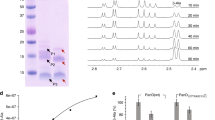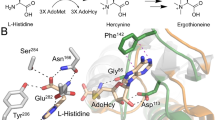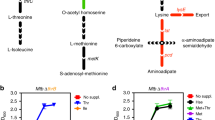Abstract
The broad-spectrum antibiotic d-cycloserine (DCS) is a key component of regimens used to treat multi- and extensively drug-resistant tuberculosis. DCS, a structural analog of d-alanine, binds to and inactivates two essential enzymes involved in peptidoglycan biosynthesis, alanine racemase (Alr) and d-Ala:d-Ala ligase. Inactivation of Alr is thought to proceed via a mechanism-based irreversible route, forming an adduct with the pyridoxal 5′-phosphate cofactor, leading to bacterial death. Inconsistent with this hypothesis, Mycobacterium tuberculosis Alr activity can be detected after exposure to clinically relevant DCS concentrations. To address this paradox, we investigated the chemical mechanism of Alr inhibition by DCS. Inhibition of M. tuberculosis Alr and other Alrs is reversible, mechanistically revealed by a previously unidentified DCS-adduct hydrolysis. Dissociation and subsequent rearrangement to a stable substituted oxime explains Alr reactivation in the cellular milieu. This knowledge provides a novel route for discovery of improved Alr inhibitors against M. tuberculosis and other bacteria.

This is a preview of subscription content, access via your institution
Access options
Access Nature and 54 other Nature Portfolio journals
Get Nature+, our best-value online-access subscription
$29.99 / 30 days
cancel any time
Subscribe to this journal
Receive 12 print issues and online access
$259.00 per year
only $21.58 per issue
Buy this article
- Purchase on Springer Link
- Instant access to full article PDF
Prices may be subject to local taxes which are calculated during checkout






Similar content being viewed by others
Data availability
Crystallographic atomic coordinates and structure factors have been deposited in the PDB under accession code 6SCZ. The data that support the findings of this study are available from the corresponding author upon reasonable request.
References
Harris, D. A. et al. Discovery, development, and antimicrobial properties of d-4-amino-3-isoxazolidone (oxamycin), a new antibiotic produced by Streptomyces garyphalus n. sp. Antibiot. Chemother. 5, 183–190 (1955).
Caminero, J. A., Sotgiu, G., Zumla, A. & Migliori, G. B. Best drug treatment for multidrug-resistant and extensively drug-resistant tuberculosis. Lancet Infect. Dis. 10, 621–629 (2010).
Walsh, C. T. Enzymes in the d-alanine branch of bacterial cell wall peptidoglycan assembly. J. Biol. Chem. 264, 2393–2396 (1989).
Batson, S. et al. Inhibition of d-Ala:d-Ala ligase through a phosphorylated form of the antibiotic d-cycloserine. Nat. Commun. 8, 1939 (2017).
Mullins, L. S., Zawadzke, L. E., Walsh, C. T. & Raushel, F. M. Kinetic evidence for the formation of d-alanyl phosphate in the mechanism of d-alanyl-d-alanine ligase. J. Biol. Chem. 265, 8993–8998 (1990).
Fenn, T. D., Stamper, G. F., Morollo, A. A. & Ringe, D. A side reaction of alanine racemase: transamination of cycloserine. Biochemistry 42, 5775–5783 (2003).
Olson, G. T., Fu, M., Lau, S., Rinehart, K. L. & Silverman, R. B. An aromatization mechanism of inactivation of γ-aminobutyric acid aminotransferase for the antibiotic l-cycloserine. J. Am. Chem. Soc. 120, 2256–2267 (1998).
Peisach, D., Chipman, D. M., Van Ophem, P. W., Manning, J. M. & Ringe, D. d-Cycloserineinactivation of d-amino acid aminotransferase leads to a stable noncovalent protein complex with an aromatic cycloserine-PLP derivative. J. Am. Chem. Soc. 120, 2268–2274 (1998).
Noda, M., Matoba, Y., Kumagai, T. & Sugiyama, M. Structural evidence that alanine racemase from a d-cycloserine-producing microorganism exhibits resistance to its own product. J. Biol. Chem. 279, 46153–46161 (2004).
Wu, D. et al. Residues Asp164 and Glu165 at the substrate entryway function potently in substrate orientation of alanine racemase from E. coli: enzymatic characterization with crystal structure analysis. Protein Sci. 17, 1066–1076 (2008).
Priyadarshi, A. et al. Structural insights into the alanine racemase from Enterococcus faecalis. Biochim Biophys. Acta 1794, 1030–1040 (2009).
Asojo, O. A. et al. Structural and biochemical analyses of alanine racemase from the multidrug-resistant Clostridium difficile strain 630. Acta Crystallogr. D Biol. Crystallogr. 70, 1922–1933 (2014).
Tassoni, R., van der Aart, L. T., Ubbink, M., van Wezel, G. P. & Pannu, N. S. Structural and functional characterization of the alanine racemase from Streptomyces coelicolor A3(2). Biochem. Biophys. Res Commun. 483, 122–128 (2017).
LeMagueres, P. et al. The 1.9 A crystal structure of alanine racemase from Mycobacterium tuberculosis contains a conserved entryway into the active site. Biochemistry 44, 1471–1481 (2005).
Prosser, G. A. & de Carvalho, L. P. Metabolomics reveal d-alanine:d-alanine ligase as the target of d-cycloserine in Mycobacterium tuberculosis. ACS Med. Chem. Lett. 4, 1233–1237 (2013).
Halouska, S. et al. Metabolomics analysis identifies d-alanine-d-alanine ligase as the primary lethal target of d-cycloserine in mycobacteria. J. Proteome Res 13, 1065–1076 (2014).
Evangelopoulos, D. et al. Comparative fitness analysis of d-cycloserine resistant mutants reveals both fitness-neutral and high-fitness cost genotypes. Nat. Commun. 10, 4177 (2019).
Copeland, R. A. Evaluation of Enzyme Inhibitors in Drug Discovery: A Guide for Medicinal Chemists and Pharmacologists (Wiley, 2005).
Kurokawa, Y., Watanabe, A., Yoshimura, T., Esaki, N. & Soda, K. Transamination as a side-reaction catalyzed by alanine racemase of Bacillus stearothermophilus. J. Biochem 124, 1163–1169 (1998).
Wang, E. & Walsh, C. Suicide substrates for the alanine racemase of Escherichia coli B. Biochemistry 17, 1313–1321 (1978).
Noda, M. et al. Self-protection mechanism in d-cycloserine-producing Streptomyces lavendulae. Gene cloning, characterization, and kinetics of its alanine racemase and d-alanyl-d-alanine ligase, which are target enzymes of d-cycloserine. J. Biol. Chem. 279, 46143–46152 (2004).
Ahmed, S. A., Esaki, N., Tanaka, H. & Soda, K. Mechanism of alpha-amino-epsilon-caprolactam racemase reaction. Biochemistry 25, 385–388 (1986).
Churchich, J. E. Fluorescence properties of pyridoxamine 5-phosphate. Biochim. Biophys. Acta 102, 280–288 (1965).
Churchich, J. E. & Farrelly, J. G. Mechanism of binding of pyridoxamine 5-phosphate to the apoenzyme aspartate aminotransferase. Fluorescence studies. J. Biol. Chem. 244, 3685–3690 (1969).
Bridges, J. W., Davies, D. S. & Williams, R. T. Fluorescence studies on some hydroxypyridines including compounds of the vitamin B6 group. Biochem. J. 98, 451–468 (1966).
Bueno, C. & Encinas, M. V. Photophysical and photochemical studies of pyridoxamine. Helvetica Chim. Acta 86, 3363–3375 (2003).
Chan-Huot, M. et al. NMR studies of protonation and hydrogen bond states of internal aldimines of pyridoxal 5′-phosphate acid-base in alanine racemase, aspartate aminotransferase, and poly-l-lysine. J. Am. Chem. Soc. 135, 18160–18175 (2013).
Khomutov, R. M, Karpeisky, M. Y. A. & Severin, E. S. The predetermined synthesis of inhibitors for pyridoxalic enzymes. Chemical and biological aspects of pyridoxal catalysis. In Proc. Symposium International Union of Biochemistry, Rome, October 1962 Vol. 30 (Snell, E.E.) 313–321 (Pergamon, Symposium Publications Division, 1963).
Feng, Z. & Barletta, R. G. Roles of Mycobacterium smegmatis d-alanine:d-alanine ligase and d-alanine racemase in the mechanisms of action of and resistance to the peptidoglycan inhibitor d-cycloserine. Antimicrob. Agents Chemother. 47, 283–291 (2003).
Churchich, J. E. The interaction of cycloserine with glutamate aspartate transaminase as measured by fluorescence spectroscopy. J. Biol. Chem. 242, 4414–4417 (1967).
Ju, J. et al. Correlation between catalytic activity and monomer-dimer equilibrium of bacterial alanine racemases. J. Biochem 149, 83–89 (2011).
Strych, U. & Benedik, M. J. Mutant analysis shows that alanine racemases from Pseudomonas aeruginosa and Escherichia coli are dimeric. J. Bacteriol. 184, 4321–4325 (2002).
Ondrechen, M. J., Briggs, J. M. & McCammon, J. A. A model for enzyme-substrate interaction in alanine racemase. J. Am. Chem. Soc. 123, 2830–2834 (2001).
Batt, S. M. et al. Structural basis of inhibition of Mycobacterium tuberculosis DprE1 by benzothiazinone inhibitors. Proc. Natl Acad. Sci. USA 109, 11354–11359 (2012).
Prosser, G. A. et al. Glutamate racemase is the primary target of beta-chloro-d-alanine in Mycobacterium tuberculosis. Antimicrob. Agents Chemother. 60, 6091–6099 (2016).
Winter, G. xia2: an expert system for macromolecular crystallography data reduction. J. Appl. Crystallogr. 43, 186–190 (2010).
McCoy, A. J. et al. Phaser crystallographic software. J. Appl. Crystallogr. 40, 658–674 (2007).
Emsley, P. & Cowtan, K. Coot: model-building tools for molecular graphics. Acta Crystallogr. D Biol. Crystallogr. 60, 2126–2132 (2004).
Afonine, P. V. et al. Towards automated crystallographic structure refinement with phenix.refine. Acta Crystallogr. D Biol. Crystallogr. 68, 352–367 (2012).
Acknowledgements
We thank V.L. Schramm, R. Guimarães da Silva, C. Melo Czekster and S.R. Lovell-Read for critical reading of the manuscript and P. Walker for help with crystallographic data acquisition at an early stage of the project. Work in the Mycobacterial Metabolism and Antibiotic Research Laboratory was chiefly supported by the Francis Crick Institute, which receives its core funding from Cancer Research UK (grant no. FC001060), the UK Medical Research Council (grant no. FC001060), the Wellcome Trust (grant no. FC001060) and also by a Wellcome Trust New Investigator Award 104785/B/14/Z (to L.P.S.C). NMR data were recorded at the MRC Biomedical NMR Centre at the Francis Crick Institute, which receives core funding from Cancer Research UK (grant no. FC001029), the Medical Research Council (grant no. FC001029) and the Wellcome Trust (grant no. FC001029). We acknowledge I04–1 beamline of the Diamond Light Source Synchrotron (Oxford, UK, mx13775-39).
Author information
Authors and Affiliations
Contributions
The work was designed and started by G.A.P. and L.P.S.C. Cloning, expression, purification and inhibition kinetics and deuteration experiments were carried out by G.A.P. UV-vis, fluorescence and circular dichroism spectroscopy experiments were carried out by M.H and C.d.C. Design and synthesis of the isoxazole compound 6 was carried out by M.H. and E.W.T. NMR analysis of compounds from chemistry and from enzymes was carried out by C.d.C. and M.H. with the assistance of G.K. Mass spectrometry analysis of compounds from chemistry and from enzymes was carried out by H.L.D. and A.G.G. X-ray data collection and analysis was carried out by C.d.C. and A.G.P. The manuscript was prepared by C.d.C., M.H. and L.P.S.C., with critical input from all the authors.
Corresponding author
Ethics declarations
Competing interests
The authors declare no competing interests.
Additional information
Publisher’s note Springer Nature remains neutral with regard to jurisdictional claims in published maps and institutional affiliations.
Supplementary information
Supplementary Information
Supplementary Table 1 and Figs. 1–4.
Rights and permissions
About this article
Cite this article
de Chiara, C., Homšak, M., Prosser, G.A. et al. d-Cycloserine destruction by alanine racemase and the limit of irreversible inhibition. Nat Chem Biol 16, 686–694 (2020). https://doi.org/10.1038/s41589-020-0498-9
Received:
Accepted:
Published:
Issue Date:
DOI: https://doi.org/10.1038/s41589-020-0498-9
This article is cited by
-
A pyridoxal 5′-phosphate-dependent Mannich cyclase
Nature Catalysis (2023)
-
The implication of Mycobacterium tuberculosis-mediated metabolism of targeted xenobiotics
Nature Reviews Chemistry (2023)



